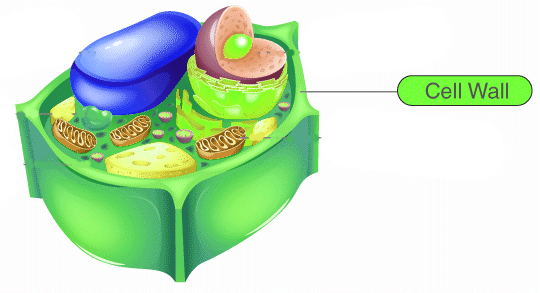
Non-living part of the plant cell is
(a) Nucleus
(b) Cytoplasm
(c) Mitochondrion
(d) Cell wall
Answer
417.5k+ views
Hint: Non-living parts lack protoplasm and thus no metabolic activities are performed in such parts. Also, these parts do not take part in the chemical reactions that occur in the cytoplasm of the cells.
Complete answer:
In a plant cell, the cell wall is the only part that is non-living because it is an extracellular product and exists outside the living boundary of the cell i.e. the plasma membrane and protects the cell besides providing it a definite shape.
A cell wall can be seen in the diagram below –
Additional information: In the plant cell walls, three layers can be present –
1. Primary cell wall – this layer is a generally flexible and thin layer formed while the cell is growing and is composed of cellulose, hemicellulose, and pectin.
2. Secondary cell wall – this is a thick layer that is formed inside the primary cell wall after the cell is fully grown and is found in some cells only like the conducting cells in xylem. It may contain polymers like cellulose, xylan, lignin, etc.
3. Middle lamella – this layer rich in pectins and is the outermost layer. It forms the interface between adjacent plant cells.
So, the correct answer is ‘Cell wall’.
Note:
1. Nucleus, cytoplasm, and mitochondria are the living parts of the cell because they are the components of the protoplast of the cell and help in carrying out various cellular metabolic activities.
2. The cytoplasm hosts many organelles and molecules and is a site for the chemical reactions occurring in a cell.
3. The nucleus contains the DNA and thus regulates the reproduction and division related activities. It also controls other metabolic activities by synthesizing appropriate enzymes with the help of DNA.
4. Mitochondria fulfill the energy demands of the cell as it synthesizes the ATP and thus acts as a powerhouse for the cell.

Complete answer:
In a plant cell, the cell wall is the only part that is non-living because it is an extracellular product and exists outside the living boundary of the cell i.e. the plasma membrane and protects the cell besides providing it a definite shape.
A cell wall can be seen in the diagram below –
Additional information: In the plant cell walls, three layers can be present –
1. Primary cell wall – this layer is a generally flexible and thin layer formed while the cell is growing and is composed of cellulose, hemicellulose, and pectin.
2. Secondary cell wall – this is a thick layer that is formed inside the primary cell wall after the cell is fully grown and is found in some cells only like the conducting cells in xylem. It may contain polymers like cellulose, xylan, lignin, etc.
3. Middle lamella – this layer rich in pectins and is the outermost layer. It forms the interface between adjacent plant cells.
So, the correct answer is ‘Cell wall’.
Note:
1. Nucleus, cytoplasm, and mitochondria are the living parts of the cell because they are the components of the protoplast of the cell and help in carrying out various cellular metabolic activities.
2. The cytoplasm hosts many organelles and molecules and is a site for the chemical reactions occurring in a cell.
3. The nucleus contains the DNA and thus regulates the reproduction and division related activities. It also controls other metabolic activities by synthesizing appropriate enzymes with the help of DNA.
4. Mitochondria fulfill the energy demands of the cell as it synthesizes the ATP and thus acts as a powerhouse for the cell.

Recently Updated Pages
Master Class 9 General Knowledge: Engaging Questions & Answers for Success

Master Class 9 English: Engaging Questions & Answers for Success

Master Class 9 Science: Engaging Questions & Answers for Success

Master Class 9 Social Science: Engaging Questions & Answers for Success

Master Class 9 Maths: Engaging Questions & Answers for Success

Class 9 Question and Answer - Your Ultimate Solutions Guide

Trending doubts
Fill the blanks with the suitable prepositions 1 The class 9 english CBSE

How do you graph the function fx 4x class 9 maths CBSE

Difference Between Plant Cell and Animal Cell

What is pollution? How many types of pollution? Define it

What is the color of ferrous sulphate crystals? How does this color change after heating? Name the products formed on strongly heating ferrous sulphate crystals. What type of chemical reaction occurs in this type of change.

Distinguish between Conventional and nonconventional class 9 social science CBSE




